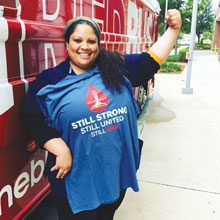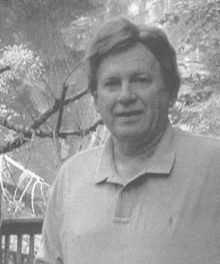 The Big Red Bus. We’ve all seen it, all over the Lowcountry - whether crossing the Broad River Bridge, winding its way down Boundary Street, heading over the McTeer Bridge or parked at a spot near Fripp Island. It’s big, bright red, and marked with the message, “Get on the bus and give blood today.”
The Big Red Bus. We’ve all seen it, all over the Lowcountry - whether crossing the Broad River Bridge, winding its way down Boundary Street, heading over the McTeer Bridge or parked at a spot near Fripp Island. It’s big, bright red, and marked with the message, “Get on the bus and give blood today.”
You can’t miss it. And you shouldn’t.
The Big Red Bus is synonymous with saving lives. And this new symbol operated by OneBlood, previously The Blood Alliance, carries on with the life-saving mission of taking donations which supply our hospitals. That includes Beaufort Memorial Hospital (BMH). Blood drives are held at organizations not only on Port Royal Island, but all along the South Carolina Coast.
Blood drive held at BMH take on a significant meaning because the hospital utilizes blood that is transfused into patients every day. Blood drives were initially held at BMH for employees and members of the community. That has all changed now with the addition of the Big Red Bus. Coordinated by BMH, the bus is able to cover six drives over five days in five locations – The Main Hospital, the BMH Administration Center, Varnvill (Hampton), Lady’s Island Internal Medicine Center, Keyserling Cancer Center and The Low Country Medical Group.
The bus is staffed by OneBlood’s team of phlebotomists, who are based out of their Boundary Street Center. The six-bed bus allows staff members to collect donations from six people at the same time. A team member will register the donors and review their histories, while others start the donor process. The process of registering and donating usually takes about 45 minutes.
Street Center. The six-bed bus allows staff members to collect donations from six people at the same time. A team member will register the donors and review their histories, while others start the donor process. The process of registering and donating usually takes about 45 minutes.
OneBlood’s mission is to provide the blood needed for all types of medical procedures, whether they are emergencies, transfusions for babies, routine surgeries or treatment for cancer patients. OneBlood will routinely need 4 to 5 hundred donations to supply all the hospitals in the Lowcountry, including the Naval Hospital, BMH, Hilton Head and Coastal Carolina. Blood is also supplied to East Cooper Medical Center in Charleston.
After blood is donated, test tubes are sent to a large lab in St. Petersburg where every unit of blood is tested for over a dozen different diseases. The actual unit of blood is sent to a processing facility where it is divided into three parts: 1) fresh frozen plasma, which can be held for a year; 2) blood platelets (the clotting component of blood), which are used primarily for cancer patients who can’t produce their own; and 3) red blood cells, which can be kept for 42 days. Red blood cells are used for a multitude of surgeries, including traumas situations, emergencies and routine procedures. One unit of blood can impact the lives of three different individuals. The list of life saving transfusions is long. Among those- transfusions for cancer and sickle cell anemia patients, who depend on a constant supply of donated blood to live.
 It’s obvious the Big Red Bus has an amazing impact on life in the Lowcountry. Its impact will be even greater when more people recognize the need to give blood and take a little time out of their busy schedules to help others. With summer upon us, there is an increase in the need for blood due to more car accidents, more outdoor accidents, and an increase in tourism. Also, OneBlood, like all blood centers, collects less blood from high schools and colleges during the summer. They have to make up for the deficit of 15 to 20 percent by holding extra blood drives during summer months.
It’s obvious the Big Red Bus has an amazing impact on life in the Lowcountry. Its impact will be even greater when more people recognize the need to give blood and take a little time out of their busy schedules to help others. With summer upon us, there is an increase in the need for blood due to more car accidents, more outdoor accidents, and an increase in tourism. Also, OneBlood, like all blood centers, collects less blood from high schools and colleges during the summer. They have to make up for the deficit of 15 to 20 percent by holding extra blood drives during summer months.
Sue Fillmore, the blood drive chairperson for the BMH Donor Center, understands the constant need for blood than most of us. She has been not only a strong advocate of blood donations, but knows firsthand that donated blood is crucial. A former Marine, Fillmore, a Beaufort resident, runs the blood drives at BMH with military precision. She is invested in the mission and cause.
Fillmore is a mother of three ‘ two daughters in Charleston (Navy and CPA) and a son (personal trainer) in Colorado. Her husband, whom she met while stationed at Guantanimo Bay, Cuba is also a retired Marine, a former teacher at Whale Branch Early College High School, and now a professor at Technical College of LowCounty (TCL). She also is a member of her church choir, volunteers for Relay for Life and the BMH Foundation, and whenever she finds a rare free moment, will sit down to sew and crochet, mostly for her family and friends.
And Fillmore is also a blood donor. “I have donated 20 gallons so far and my objective is 25 (and then 30 etc.),” she says. “I believe very strongly in giving back to the community.”
The Big Red Bus can travel most anywhere to make it convenient for blood donors to give – all it needs is a place to park. If any organization wants to sponsor a drive (and they are encouraged to do so), OneBlood will supply the communications and marketing, including posters, table tops, emails. They also supply the chairperson, like Fillmore, with a webpage about the blood drive. This allows them to have potential blood donors sign up before donating.
As Fillmore reminds us, “It is so important for all of us to give back to our community, and as a blood donor, it takes only 30 minutes of your time to help another person have a second chance to live.”
To schedule a Blood Drive with the Big Red Bus, please contact operations manager Karen S. Wyman at OneBlood, 843-522-0409.








